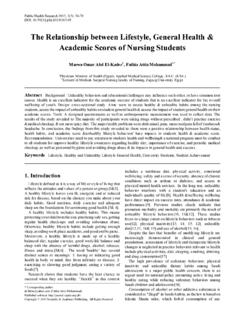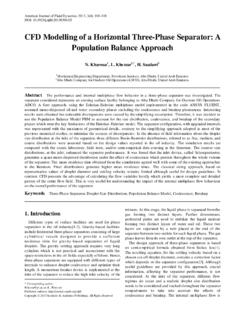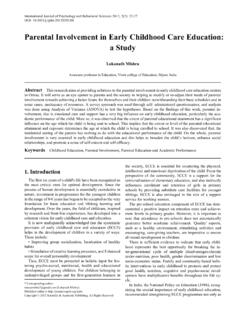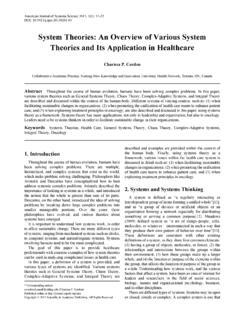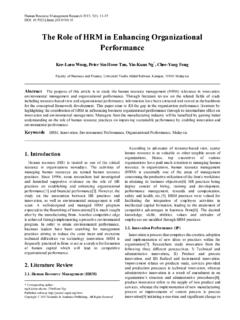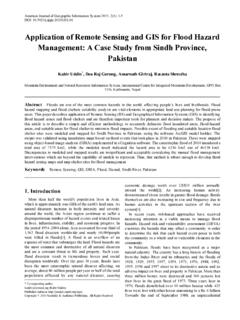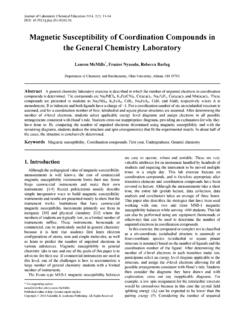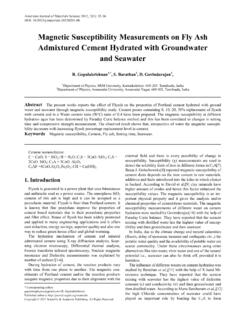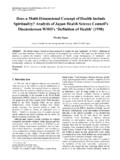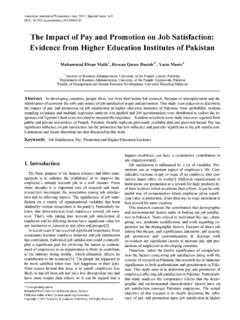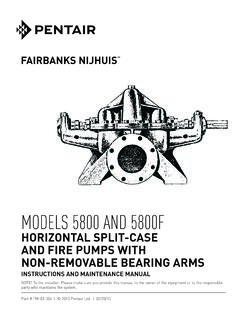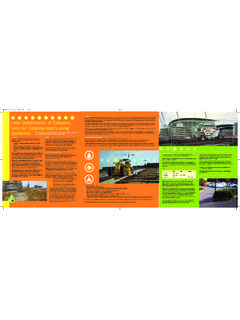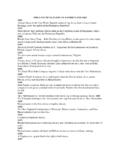Transcription of California Bearing Ratio (CBR), Plate Load Test (PLT ...
1 Journal of Civil Engineering Research 2012, 2(1): 34-40 DOI: Evaluation of Modulus of Elasticity and Modulus of Subgrade Reaction of Soils Using CBR Test Elsa Eka Putri*, N. Kameswara Rao, M. A. Mannan Civil Engineering, Universiti Malaysia Sabah, Kota Kinabalu, Sabah, 88999, Malaysia Abstract This paper presents the procedure of evaluation of the modulus of elasticity (E) and the modulus of subgrade reaction (ks) value based on the California Bearing Ratio (CBR) tests and FEM analysis. The pressure-displacement re-sponse of the soil in the CBR mould is simulated using Cosmosworks FEM model where the soil, the load plunger, and the steel mould of CBR are represented. The correlation of Modulus of Elasticity (E) with California Bearing Ratio (CBR) is developed based on the elastic properties of the soil sample. Furthermore, the correlation between E and CBR is proposed.
2 Using the E values, modulus of subgrade reaction can be calculated and vice versa as well. Thus CBR test is expected to simplify the effort in determination of the modulus of subgrade reaction which is used in Foundation design, soil structure interaction, design of highway formations etc. Keywords California Bearing Ratio (CBR), Plate Load Test (PLT), Modulus of Elasticity (E), Modulus of Subgrade Reaction (ks), CosmosWorks FEM 1. Introduction In highway formations the subgrade layer, where acts as a pavement foundation should be well designed. To evaluate the subgrade strength is important during construction and design stage. The California Bearing Ratio (CBR) test is commonly used to determine the suitability of a soil as a subgrade or subbase for highway and runway design and construction. Field Plate load test is commonly used to pre-dict the deformations and failure characteristics of the soil/subgrade and modulus of subgrade reaction (ks).
3 Modulus of subgrade reaction (ks) is used in foundation design, soil-structure interaction studies and design of highway pavement (flexible and rigid pavements). One of the parameters obtained from the field Plate load test is the spring constant/ modulus of subgrade reaction, ks-value. The ks-value is used as a primary input in pave-ment design models, and is based on Minnesota Department of Transport (MnDot) pavement design. It can be measured using a field Plate load test conducted on top of the sub-grade (Kameswara Rao, 2000; MnDoT, 2007). However, this test is costly to perform besides being time consuming. Also it is difficult to conduct a Plate load test at depths be-yond 1 or 2 m below Ground Level (GL). As presented in Figure 1, the CBR test procedure is * Corresponding author: (Elsa Eka Putri) Published online at Copyright 2012 Scientific & Academic Publishing.
4 All Rights Reserved somewhat similar to the Plate load test. As the load is i m-posed on the sample soil, the deflection will occur. The Plate is placed at the proposed level of the foundation and is subjected to incremental loading. The size of the Plate can be 300 mm to 760 mm in diameter and the shape is square, rectangular, or circular (Jones, 1997; Moayed and Janbaz, 2009). (a) CBR test set up (b) Field Plate load test set up Figure 1. Figure of CBR and PLT set up The CBR test can also be used to get the curve of the load settlement of the soil in the field which is more or less similar to the Plate load test objective. By this idea, the value of ks can also be obtained from the CBR test as de-scribed below. In this investigation, the correlation of CBR versus E then CBR versus ks are developed to bridge the gap which is much needed to integrate the engineering behaviour of these two hitherto uncorrelated tests, though concerned with the same subgrade properties needed for engineering design of foundations and pavements.
5 This correlation will also fa-cilitate integrating, complimenting and improving the de- Journal of Civil Engineering Research. 2012; 2(1): 34-40 35 sign procedures based on CBR value and ks used in high-way engineering as well as foundation engineering. 2. Literature Review The modulus of subgrade reaction, ks (also referred to as Coefficient of Elastic Uniform Compression, Cu) is a rela-tionship between soil pressure and deflection which is pro-portional to its vertical displacement as idealized in Winkler s soil model (Hetenyi, 1946; Jones, 1997). It can also be defined as the Ratio of uniform pressure imposed on the soil to the elastic part of the settlement (Kameswara Rao, 2000). Very little work has been reported for the correlation between modulus of subgrade reaction (ks) and CBR test though the mechanism of deformation is similar.
6 Terzaghi (1955) studied the various parameters of the Plate load test using a circular Plate of 760 mm diameter and thickness of 16 mm. He also proposed an empirical correlation between CBR and E as shown in Figure 2 (Jones, 1997). Figure 2 also presents the empirical correlations be-tween modulus of elasticity, E with CBR that have been worked out by Heukelom and Klomp (1962), NAASRA (1950) and Powell, Potter, Mayhew and Nunn (1984). Figure 2. California Bearing Ratio versus Modulus of Elasticity Heukelom and Klomp (1962) studied the correlation of CBR with E and proposed on empirical relationship as, E = 1500 CBR (Psi) (1) This correlation is only for fine grained non expansive soils with a soaked CBR < 100% (AASHTO, 1993). Moreover, Powell et. al (1984) proposed a correlation of the CBR with E as, E = (MPa) (2) Thus, the correlation between E and CBR developed by NAASRA (1950) has been divided into two parts.
7 For CBR less than 5, E = (MPa) (3) Then, for CBR more than 5, E = (MPa) (4) These correlations between E and CBR were developed using empirical methods which are validated using other sets of tests data based on the experimental tests in the laboratory. In order to develop the procedure to correlate the CBR result with the PLT result, the finite element method is used to model the CBR test with input parameter obtained from the laboratory testing. It offers a rational approach to de-velop the correlation of CBR versus E. These values are subsequently used for evaluating the modulus of subgrade reaction, thus providing an easier way for analysis of soil structure interaction and pavements. 3. Methodology The CBR test is modelled using FEM to work out the pressure response relationship.
8 The finite element model was assembled using the Cosmoswork SolidWork 2005. The CBR mould model in Cosmosworks consists of base Plate , cylinder mould, and load plunger and those are speci-fied as steel in the input. The structural properties of the soil subgrade were required as input data. These are the density, modulus of elasticity and Poisson s Ratio . Poisson s Ratio is a property of elastic materials assumed to be in between of to The Poisson s Ratio of zero is usually used for dry soil and the value of is usually used for saturated soils. It is usually assumed due to the difficulties in its determination in the laboratory or in the field, while recognizing that elas-tic responses of the medium are not very sensitive to changes in the value of Poisson s Ratio (Bowles, 1984). Thus, it does not significantly affect the elastic response of the soil though it can vary from 0 to (Harr, 1966, Kameswara Rao, 2000).
9 Finite element analysis was carried out with a range of value of E (modulus of elasticity) chosen from +6 Pa until +7 Pa for finding the load deflection curves. From these, the load penetration of of the CBR plunger (of mm diameter) is chosen for the determina-tion of CBR value (BS 1377:1990). Finite element analysis can also be used to determine the response of vertically loaded plunger in layered elastic media. It is noted that the FEM analysis gives different val-ues of deflection at the centre of the CBR plunger and at the edge though the mould is practically very rigid. In order to relate the finite element result with the CBR test in the laboratory, the elastic analysis has been corrected to that corresponding to rigid analysis using the analytical results given by Tsytovich (Harr, 1966 results).
10 Hence, the central deflection of the plunger is corrected to obtain the corre-sponding deflection of the rigid plunger using the results of Tsytovich (Harr, 1966). Thus the deflection at the centre of circular shaped loaded area of the CBR plunger should be multiplied by the influence factor K = (= /4) as per Tsytovich, to get the corresponding value of the deflection of the rigid plunger of the CBR mould transferring the load + + + + + + + +08020406080100E (Pa)CBR (%)heukelom&klom 1962 Powell et al, 1984 NAASRA (1950)36 Elsa Eka Putri et al.: Evaluation of Modulus of Elasticity and Modulus of Subgrade Reaction of Soils Using CBR Test to the soil. The procedure of correlation CBR versus E then CBR versus Plate Load test is developed as presented in Figure 3. Figure 3. Flow chart of the procedure to predict the PLT result 4.
